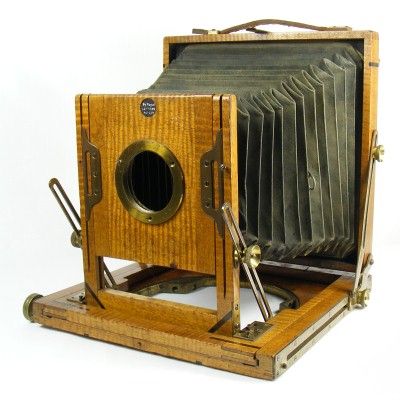Unnamed Field Camera (By Royal Letters Patent)
Midland Camera Company
| Name: | Unknown but marked "By Royal Letters Patent" |
| Type: | Field Camera |
| Manufacturer: | Midland Camera Company |
| Country of Origin: | United Kingdom |
| Construction: | The camera is constructed of light Honduran fiddle-back mahogany, with simple finger or comb joints. It has strips of ebony inlaid across a number of the joints. It is fitted with tapered chamfered double extension bellows. |
| Production Period: | Unknown |
| Plate / Film Size: | ½ plate |
| Lens: | Missing |
| Shutter: | None |
| Movements: | Rising front, tilting front and back, swing back. Reversible back |
| Dimensions (w x h x l): | |
| Date of this Example: | c1900 |
| Serial Number: | None |
| Availability: |
|
| Inventory Number: | 589 |
|
Photos copyright © 2011 David Purcell. Do not use without permission. |
Description
This field camera has several unusual design features. The only marking is a black round label on the lens standard that bears the legend "By Royal LETTERS PATENT" in white lettering. While the manufacturer is not identified on the camera itself, the design had led to the identification of the maker as the Midland Camera Company. Refer to the Notes below for further details.
The camera is constructed of light Honduran fiddle-back mahogany. It has strips of ebony inlaid across a number of the joints (as opposed to being brass bound), including across the corners of the base, the frame for the ground glass screen, the bottom of the lens standard supports and the front and rear edges of the inner focussing frame. The joints in the frame are simple finger or comb joints. It is fitted with leather tapered chamfered double extension bellows. The bellows are black but the colour has faded on the exposed faces.
Focussing is by rack and pinion (spiral) operating on an inner frame to which the lens standard is mounted. There are two pinions, one at the front (to allow double extension) and one at the rear to support wide angle work. The front standard fixes to the focussing frame by brass pins that fit into slots on the frame that are closed by shutters operated by curved levers. While the principle is similar to that used on the Watson Acme, the use of the unsprung levers is not something I have encountered previously. Refer to the two photos at bottom right of the set, which show the latch open and closed.
Another unusual and key feature is the mechanism used for the rising front. Brass guides slide in slots cut into the front standard, but a rack and pinion mechanism is built onto the reverse side of the front standard. Releasing the side supports allows a narrow knurled knob to be turned that operates the rack and pinion. Again, I have not encountered a device of this form on another camera.
The mechanism used to fasten the front standard to the inner frame and the rise and fall mechanism are characteristics of the camera that aid identification.
The camera has a conventional reversible back. The front and rear standard can tilt (slotted support struts); a limited amount of swing can be achieved on the rear standard. It has a rotating turntable built into the base.
Notes
I bought this camera without knowing the maker, being attracted simply by its unusual design. Discussion with another collector and historian led to the identification of a British patent (15926/1900) for the rack and pinion rising front. The patent is in the name of Charles Howell of Birmingham. The same collector was able to confirm that Howell was a partner in the Midland Camera Company at the time.
Further validation of the identity of the maker came through another collector, the late Eric Evans, who concentrated on British wood and brass cameras and had two examples of cameras made by The Midland Camera Company. Both examples were likely to be later than this camera as they carry labels identifying the maker as The Midland Camera Company Ltd (dating his examples to 1905 or later). However one of them shared several features with this camera, notably a rack and pinion rising front (albeit of a slightly different design) and ebony inlays.
![[ ]](../../images/unchecked.png)
![[x]](../../images/checked.png)








